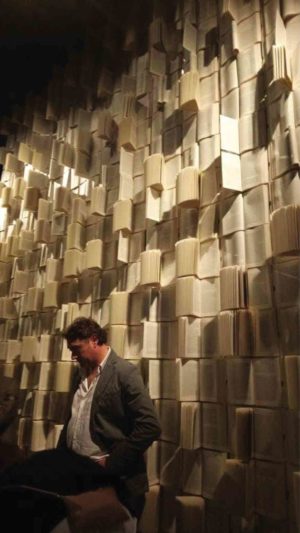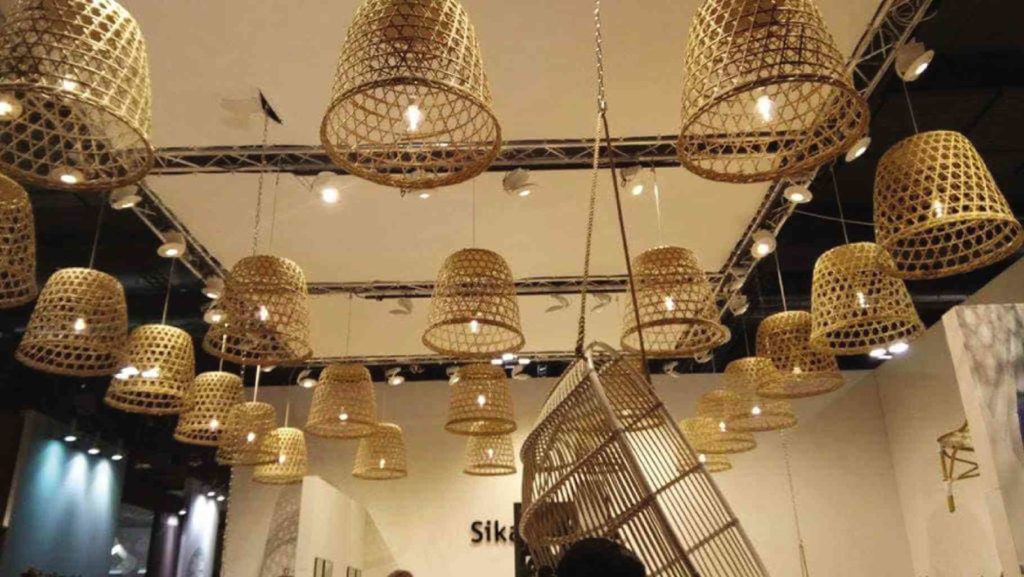Wasteland to wonderland

Old books used as decorative wall cladding
Trash disposal has been a persistent problem in many societies. And as world population continues to grow, more waste is being produced over time.
Nowadays, the world is generating too much trash for landfills to hold. In an effort to minimize material waste, we are being encouraged to recycle.
The idea of reuse, however, has yet to become prevalent in the world of modern construction.
For some Danish designers, it’s not about merely reusing objects. For them, to create architecture that saves the world, it’s all about upcycling.
Waste in the spotlight
What’s the difference between recycling and upcycling? The two both aim to ease environmental impact, but do it through different means.
Danish firm Lendager Architects explains: “Upcycling is a step beyond recycling. The materials are not just reused, but reused in a way where value and quality are added.”
Whereas recycling means reusing shipping containers, upcycling involves transforming them into something else—shops, offices, or even homes. Upcycling is reimagining and transforming an object into a repurposed commodity.
Earlier this year, the Danish Architecture Centre in Copenhagen, Denmark held an exhibition entitle “Wasteland.”
Curated by the Lendager group, the exhibit presented garbage as resources that can be used to create sustainable buildings. The exhibit focused on six common building materials that often become waste—metal, glass, concrete, wood, brick, and plastic.
The premise is that these building materials can be reused and repurposed multiple times everywhere. Instead of extracting and exporting raw materials, the exhibit encourages instead ways to integrate repurposed items into new buildings.
The exhibit showed some remarkable examples of recycling to a new level.
Wine corks were re-made into acoustic flooring. Newspapers transformed into wall claddings. Broken concrete was reused to create new structures. Repurposed materials were used to create a prototype—the Upcycle House.
As per the Lendager group, the house produces 86 percent less carbon emissions than regular houses. It is also long-lasting and market-competitive, making it suitable for urban families.

Old building parts can find new use in other structures.
When trash becomes posh
Recycled materials are often associated with low-cost construction. The 2017 Salone de Mobile, however, proved that repurposed items can also be world-class.
Held last April in Milan, Italy, the exposition brought together the latest design trends among European and global brands. Some of the exhibitors displayed upcycled products that looked better than some of their brand new counterparts.
One exhibitor showcased sculptural seats made of recycled plastic. Another made benches out of fabric leftovers pressed into sheet boards.
Lastly, a company sold vases made from rejected glass.
A lot of exhibitors also showed how ordinary products can be used to create new aesthetics. One shop used plastic cups to decorate its façade window. An exhibitor used old books to cover a wall and emphasize lighting.
Another company repurposed woven baskets into suspended lampshades.
Known for luxurious and high-end brands, it is refreshing to discover that Italy also features repurposed materials in its architecture. The showcase of upcycled products in one of the world’s best design fairs proves that there is much potential in this movement.
Future of waste
Given the persistent problem of garbage disposal, recycling and reuse have always been promoted to ease the situation. The practice, however, is no longer limited to budget construction and alternative buildings.
As design trends become more eco-friendly, the high-end market is learning to embrace the concept of sustainability and upcycled materials as well.
In a world becoming more aware of environmental issues, the attitude towards re-use is evolving. Sustainability is no longer an added or optional feature, it is becoming the norm.
Garbage is now becoming a commodity for the creative.
In the Philippines, where landfills sometimes overflow, we may be looking at resources just waiting to be tapped. With our wealth of talented architects and designers, many could probably come up with different ways waste can be transformed into something of value.
Upcycling could hold the key to solving some of our worst urban problems. We may just need to open our minds and see things in a new light.
(Sources: www.archdaily.com; https://urbannext.net; www.treehugger.com)














